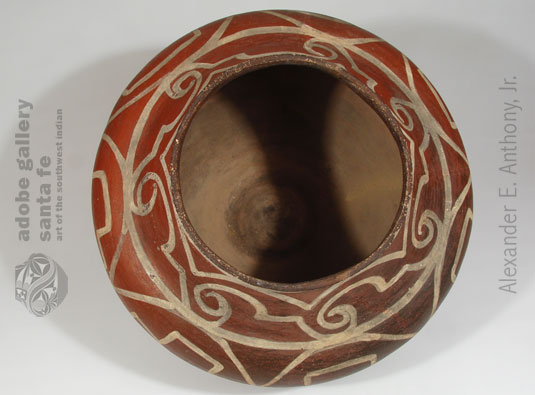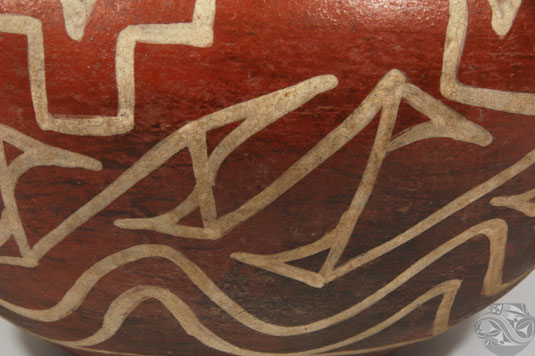RARE Zuni White on Red Pictorial Pottery Jar [SOLD]
+ Add to my watchlist Forward to Friend
- Category: Historic
- Origin: Zuni Pueblo, SHE-WE-NA
- Medium: clay, pigment
- Size: 10-1/4” height x 14-3/4” diameter
- Item # C4021 SOLD

One can only speculate what would have sparked an event of 125 years ago if it is not documented in published evidence from the period. It is well documented what the Stevenson collections of 1879 and 1885 acquired at Zuni, but it is equally important to note what he did not collect. There were no Zuni White-on-red jars or bowls or any other vessel shapes in the Stevenson collections. Had the White-on-red style existed at the time, he would surely have collected examples for the Smithsonian. This lack of examples in his collections is an indication that such a style did not exist at the time, leaving the clue that it developed after his 1885 expedition. This is indeed backed up by the numerous examples collected by Winship in 1899, Pepper in 1903 and Spinden in 1910. It has therefore been determined that this style developed in the late 1890s and ended in the 1920s.
This new style could have been influenced by sherds from prehistoric St. Johns Polychrome from near the current Zuni Pueblo boundaries, or from prehistoric sherds being excavated at Hawikuh and Halona villages. Anthropologists could have shown sherds to potters or potters could have unearthed sherds themselves for use as temper. It is easy to see that these White-on-red wares of the late 1800s had a precedent at or near Zuni and were not a completely new innovation dreamed up by potters of the day. Zuni potters were aware they were reviving an ancient ware as they acknowledged this to Ruth Bunzel. Interestingly, while this revival of an ancient ware was occurring at Zuni, a similar revival of Sikyatki pottery was underway by Nampeyo at Hopi.
Why did the phase end after such a brief period? Quite possibly because museums and dealers preferred traditional Zuni Polychrome with birds and heartline deer as more representative of traditional Zuni pottery.
Most of the documented examples of White-on-red pottery display geometric designs. At first glance, one would classify the designs on this jar as geometric, however, on close examination, one sees that there is a continuous series of birds on the main body of the jar. Below the birds is a continuous undulating band comprised of parallel white lines. Above the birds is a continuous design of stepped lines alternating in an up and down orientation. The underbody is red, and the rim is black, extending down inside the neck, the only black on the jar.
The red slip that covers the entire vessel is the same red used for decorations on Zuni Polychrome pottery and the white used in the decoration is the same white slip used as a base coat on Polychrome wares. The red slip was stone polished and the white left in a matte state. Interestingly, the red slip was yellow before the firing process.
Of the many styles of Zuni pottery made in the last 150 years, this style is among the rarest. Most of the similar styles contained black along with the white in the design. Fewer jars were solely white on red.
Condition: a section of the rim was broken out when we received the jar. It was professionally restored to its original position. The section was a perfect fit to the rim so that no materials were added.
Provenance: from a gentleman in Albuquerque
Reference and Recommended Reading: The Pottery of Zuni Pueblo by Harlow and Lanmon.

- Category: Historic
- Origin: Zuni Pueblo, SHE-WE-NA
- Medium: clay, pigment
- Size: 10-1/4” height x 14-3/4” diameter
- Item # C4021 SOLD



